AMD Announces Ryzen 5 Lineup: Hex-Core from $219, Available April 11th
by Ian Cutress on March 15, 2017 10:00 PM EST_678x452.jpg)
As part of our initial Ryzen 7 review, AMD also teased the presence of two more elements to the Ryzen lineup, specifically Ryzen 5 and Ryzen 3, both aiming at a lower cost market and allowing AMD to sell some of the silicon that didn’t quite make it to the Ryzen 7 lineup. Today is the official announcement for Ryzen 5, featuring four processors in hex-core and quad-core formats, all with Simultaneous Multi-Threading (SMT) and all using the same AM4 platform as Ryzen 5.
Ryzen 5
Whereas Ryzen 7 was AMD’s main attack on high-performance x86 and a shot across the bow against Intel’s high-end desktop platform, Ryzen 5 is targeted more at mainstream users. The goal here is that where Intel has four cores with no hyperthreading, AMD can provide six cores with SMT, effectively offering three times as many threads for the same price and potentially smashing any multithreaded workload.
Without further ado, here is where the Ryzen families stand:
| AMD Ryzen 7 SKUs | |||||||
| Cores/ Threads |
Base/ Turbo |
XFR | L3 | TDP | Cost | Cooler | |
| Ryzen 7 1800X | 8/16 | 3.6/4.0 | +100 | 16 MB | 95 W | $499 | - |
| Ryzen 7 1700X | 8/16 | 3.4/3.8 | +100 | 16 MB | 95 W | $399 | - |
| Ryzen 7 1700 | 8/16 | 3.0/3.7 | +50 | 16 MB | 65 W | $329 | Spire RGB |
| AMD Ryzen 5 SKUs | |||||||
| Cores/ Threads |
Base/ Turbo |
XFR | L3 | TDP | Cost | Cooler | |
| Ryzen 5 1600X | 6/12 | 3.6/4.0 | +100 | 16 MB | 95 W | $249 | - |
| Ryzen 5 1600 | 6/12 | 3.2/3.6 | +100 | 16 MB | 65 W | $219 | Spire |
| Ryzen 5 1500X | 4/8 | 3.5/3.7 | +200 | 16 MB | 65 W | $189 | Spire |
| Ryzen 5 1400 | 4/8 | 3.2/3.4 | +50 | 8 MB | 65 W | $169 | Stealth |
Traditionally we are used to a part with fewer cores having a higher clock frequency, however perhaps due to the voltage scaling of the design, we see a matched Ryzen 5 1600X in frequency to the Ryzen 7 1800X, but the rest of the Ryzen 5 family are offered at a lower TDP instead.
All the Ryzen 5 parts are unlocked, similar to the Ryzen 7 parts, and all four exhibit some movement in XFR mode, with the 1500X offering +200 MHz depending on the cooler used. AMD is going to offer some of these SKUs with their redesigned Wraith coolers:
It is worth noting that the Wraith Spire for Ryzen 5 will not have RGB lighting, whereas the Wraith Spire for Ryzen 7 does use an RGB ring. OEMs will be able to use the higher-end Wraith Max stock cooler for their pre-built systems. AMD stated that at present, there are no plans to bring the Wraith coolers to retail as individual units, however they will keep track of how many users want them as individual items and regularly approach the issue internally.
To clarify some initial confusion, AMD has given me official TDP support numbers for the coolers. The entry level Wraith Stealth is 65W, the Wraith Spire is 65W for high-ambient conditions (AMD states this might be considered an '80W' design in low-ambient), and the Wraith Max is 95W for OEM builds using Ryzen 7 95W parts.
All the Ryzen 5 parts will support DDR4 ECC and non-ECC memory, and the memory support is the same as Ryzen 7, and will depend on how many modules and the types of modules being used. Recently companies like ADATA announced official support for AM4, as some users have found that there were memory growing pains when Ryzen 7 was launched.
Platform support for Ryzen 5, relating to PCIe lanes and chipset configurations, is identical to Ryzen 7. Each CPU offers sixteen PCIe 3.0 lanes for graphics, along with four lanes for a chipset and four lanes for storage. Chipsets can then offer up to eight PCIe 2.0 lanes which can be bifurcated up to x4 (AMD GPUs can use chipset lanes for graphics as well, however at reduced bandwidth and additional latency).
Competition
The high-end Ryzen 5 1600X, at $249, is a shoe-in to compete against Intel’s i5-7600K at $242. Intel’s CPU is based on the Kaby Lake microarchitecture, and we’ve already shown in the Ryzen 7 review that by comparison Ryzen is more circa Broadwell, which is two generations behind. AMD won’t win much when it comes to single-threaded tests here, but the multi-threaded situation is where AMD shines.
| Comparison: Ryzen 5 1600X vs Core i5-7600K | ||
| AMD Ryzen 5 1600X |
Features | Intel Core i5-7600K |
| 6 / 12 | Cores/Threads | 4 / 4 |
| 3.6 / 4.0 GHz | Base/Turbo | 3.8 / 4.2 GHz |
| 16 | PCIe 3.0 Lanes | 16 |
| 16 MB | L3 Cache | 6 MB |
| 95 W | TDP | 91 W |
| $249 | Price (MSRP) | $242 |
Here we have twelve threads against four, at a 95W TDP compared to a 91W TDP (the 1600 is 65W, which looks better on paper). It is expected that for situations where a compute workload can scale across cores and threads that the AMD chip will wipe the floor with the competition. For more generic office workloads, it will interesting to see where the marks fall.
On the quad-core parts, there are several competitive points to choose from. The AMD Ryzen 5 1500X, at $189, sits near Intel’s Core i5-7500 at $192. This would be a shootout of a base quad-core versus a quad-core with hyperthreading.
| Comparison: Ryzen 5 1500X vs Core i5-7500 | ||
| AMD Ryzen 5 1500X |
Features | Intel Core i5-7500 |
| 4 / 8 | Cores/Threads | 4 / 4 |
| 3.5 / 3.7 GHz | Base/Turbo | 3.4 / 3.8 GHz |
| 16 | PCIe 3.0 Lanes | 16 |
| 16 MB | L3 Cache | 6 MB |
| 65 W | TDP | 65 W |
| $189 | Price (MSRP) | $182 |
The reason why I didn’t pull out the Core i3-7350K there, at $168, is because the performance of the 7350K sits near the Pentium G4560, which is only $64 (and the subject of an upcoming review). That all being said, the $168 price of the i3-7350K matches up to the $169 price of the Ryzen 5 1400, although the 1400 has double the cores and double the threads of the 7350K.
Cutting up the Cores
Ryzen 5, both the hex-core and the quad-core variants, will use the same eight-core base Zeppelin silicon that Ryzen 7 does.
The silicon design consists of two core complexes (CCX) of four cores apiece, and each with 8MB of L3 cache that is an exclusive victim cache. One of the suggestions regarding Ryzen 7’s performance was about thread migration and scheduling on the core design, especially as core-to-core latency varies depending on where the cores are located (and there’s a jump between CCXes). Despite the use of AMD’s new Infinity Fabric, which is ultimately a superset of HyperTransport, there is still a slightly longer delay jumping over that CCX boundary, although the default Windows scheduler knows how to manage that boundary as demonstrated by Allyn at PCPerspective earlier this week.
So when dealing with a four-core or six-core CPU, and the base core design has eight-cores, how does AMD cut them up? It is possible for AMD to offer a 4+0, 3+1 or 2+2 design for its quad-core parts, or 4+2 and 3+3 variants for its hexacore parts, similar to the way that Intel cuts up its integrated graphics for GT1 variants. The downside with this way is that performance might differ between the variants, making it difficult to manage. The upside is that more CPUs with defects can be used.
We have confirmation from AMD that there are no silly games going to be played with Ryzen 5. The six-core parts will be a strict 3+3 combination, while the four-core parts will use 2+2. This will be true across all CPUs, ensuring a consistent performance throughout.
Performance Estimates
We won’t have these CPUs in for a while, but given our new benchmark suite and the results we’ve seen so far with Ryzen, we’ve tried to lay out some estimates in performance in both single thread and multi-threaded workloads.
Single thread performance is easy enough to estimate – we work from the turbo and XFR frequencies of each processor. For users looking for peak single thread performance, something like Intel’s Pentium G3258 or i3-7350K that can be overclocked to 5GHz+ (or starts as a base 4.2 GHz) is going to be a performance per dollar crown here. On the AMD side, we expect the Ryzen 5 1600X to match the Ryzen 7 1700X as it has the same frequency.
Multithreaded is more difficult to predict. Some of our benchmarks offer perfect scaling across cores and threads, meaning that if you half the cores, you get half the score. Some of the benchmarks are not as clear cut though, hence why we see something like Intel’s Core i3-7350K, which should get about half the score of an i7-7700K, scoring 65% instead of 50%. We’ve tried to take this into account with the Ryzen 5 parts, and we get the graph above.
The key results here show that the 1600 and 1600X should sit way above the i5-7600K, and the 1600X should offer so much better performance per dollar than the Core i7-7700K.
On overall performance, taking the combination of results (our suite is slightly unbalanced in favor of MT, but this is taken into consideration) we funnily see a straight line between the 1800X, 1700X, 1700, 1600 and 1500X, putting the 1600X at a really good position as a performance per dollar CPU.
The caveat here is that the Ryzen 7 processors came across as good workstation processors. Ryzen 7 was marketed towards that group of users, and it made sense. Ryzen 5 is more targeted towards mainstream gamers and users, which might offer some interesting results. Our results don’t feature any gaming numbers yet (still working on a Ryzen 7 part 2 for this), but it will be interesting to see how the core counts and frequency will affect gaming performance.
The Bottom Line
Ryzen 5.
Two CPUs with six-core, from $219-$249.
Two CPUs with four-core. From $169-$189.
Retail availability on April 11th.
Stay tuned for the AnandTech review.
(Ryzen 3 is still slated for 2H17.)


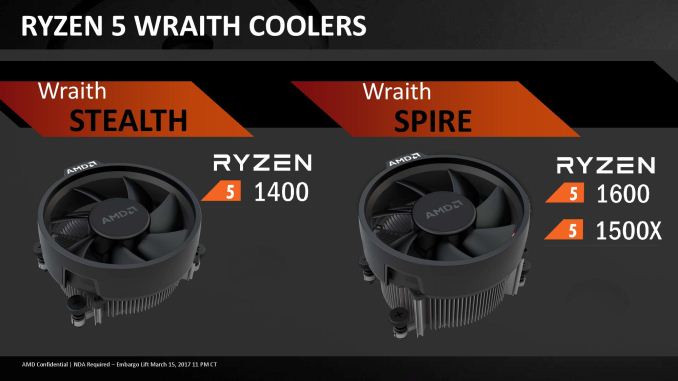
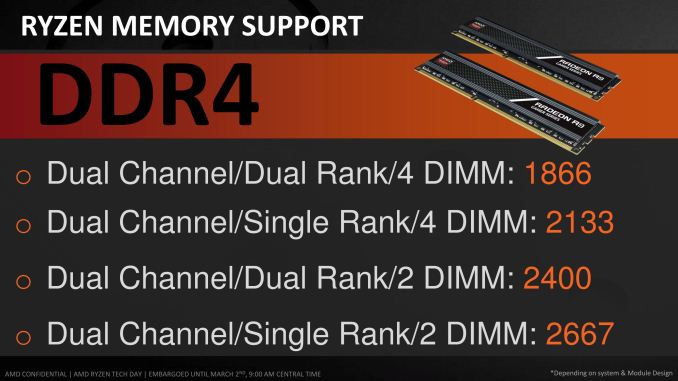
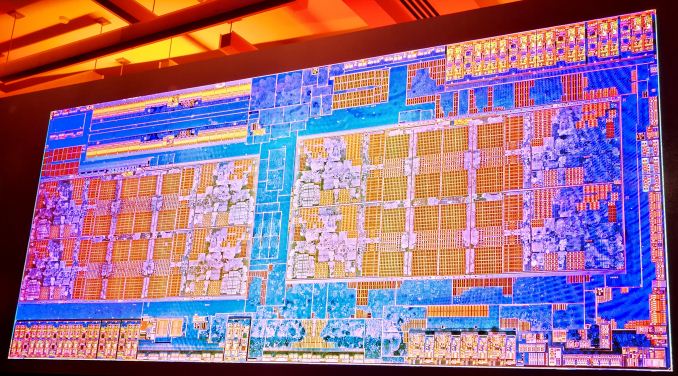
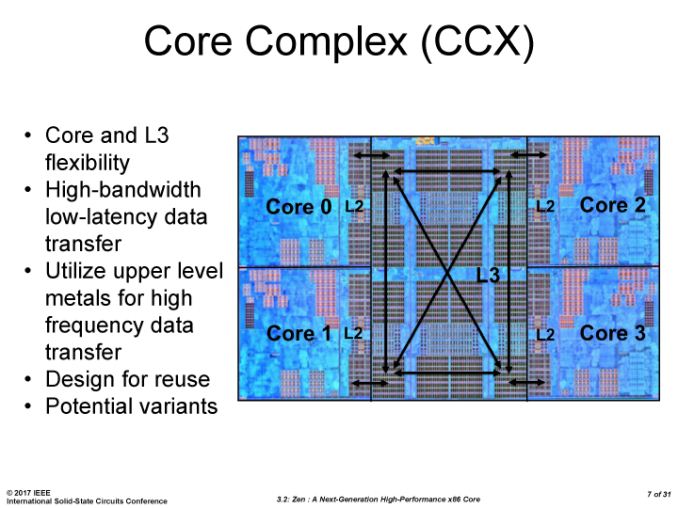
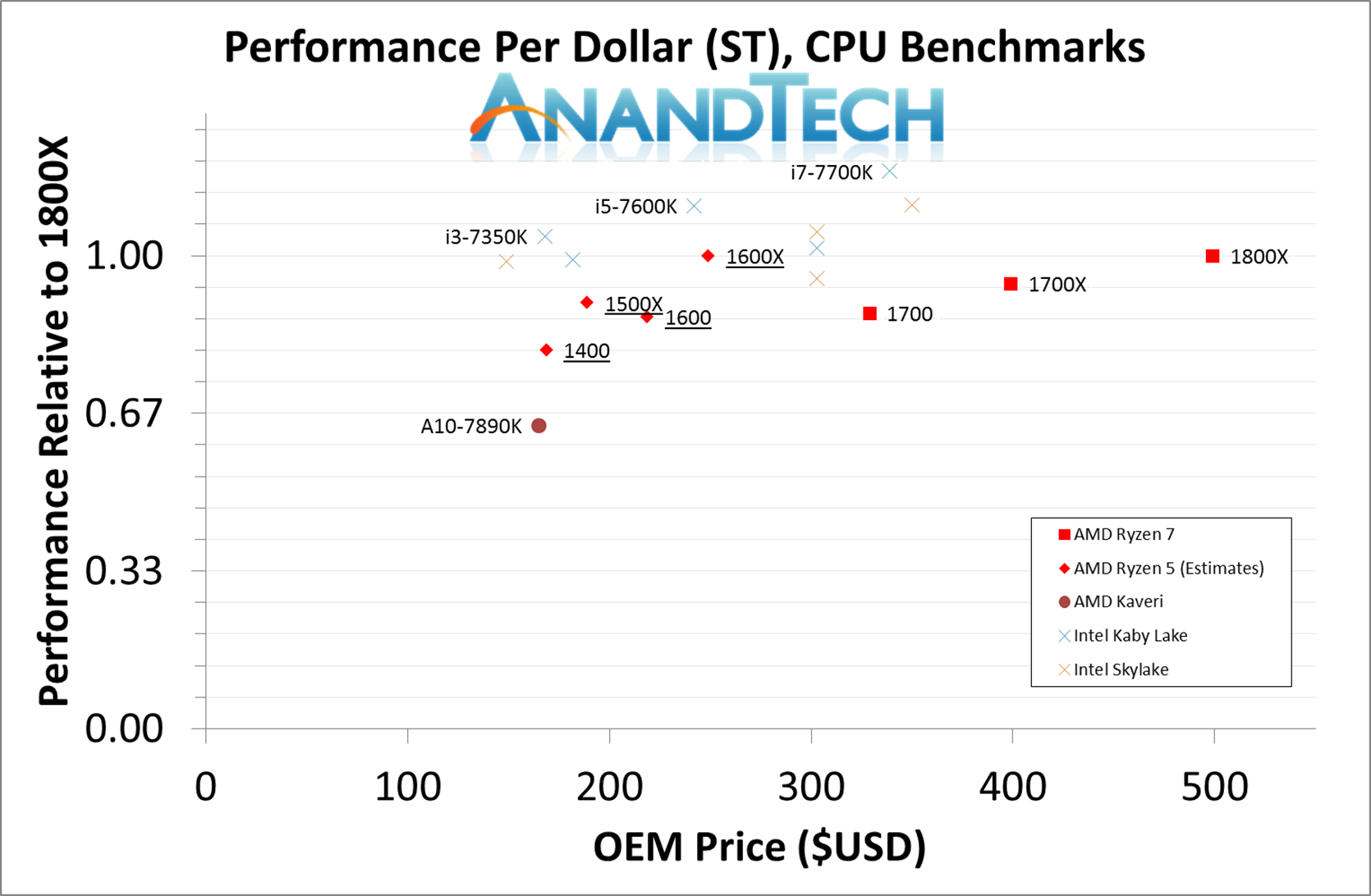


_thumb.jpg)
_thumb.jpg)
_thumb.jpg)
_thumb.jpg)
_thumb.jpg)
_thumb.jpg)








229 Comments
View All Comments
0ldman79 - Saturday, March 25, 2017 - link
Give this man a cookie.I'm the same way.
Every few years the best bang for the buck changes. It is silly to be brand loyal for any reason beyond that brand meeting your needs the best.
FMinus - Friday, March 17, 2017 - link
I would consider myself a gamer (whilst not as much as I was 10 years ago) I still game each evening a bit. And I can't stand flashy things, I remember even going this far as snipping LEDs from fans that came with a chassis back in the day.Now I'm perfectly happy with my all black aluminum Lian-Li A76 tower where I just throw in random component, it's my third system in the same chassis, nothing glows, or blinks except for the motherboard lights, and I like it that way.
albert89 - Friday, March 24, 2017 - link
I'm the same. The rig should be stealthy and silent.0ldman79 - Saturday, March 25, 2017 - link
Agreed.I've got a gaggle of big ol' case fans with the LEDs cut...
albert89 - Friday, March 24, 2017 - link
Most definitely.beginner99 - Thursday, March 16, 2017 - link
I don't think it's puzzling at all especially given reviewers mostly do stupid benches. There are few games that actually benefit from 6 or 8 slow cores over 4 fast ones and that mostly only applies to multi-player like BF1 which hardly ever is benched. So the 7700k especially OCed still comes clearly out at the top.And as has been said for high refresh rate gaming a fast CPU is a must as it must pump out 120+ frames per second. Besides that the launch issues with Ryzen and the fact it is underperforming in gaming compared to other benches will make people hesitant to buy. push them towards the known factor, eg 7700k.
AS118 - Thursday, March 16, 2017 - link
I agree. I'm an AMD fan that'll probably get an R5 1600x, but everything you say about the 7700k is true. If I had a 144fps monitor and played at 1080p, I'd probably get a 7700k. I don't get why some people knock Intel's i7's unnecessarily. They have a use, and it's not stupid to get them over a Ryzen prodcut.niva - Thursday, March 16, 2017 - link
If the usage is just for games it may be exactly stupid to get Itel over the new AMD product. As mentioned there should be issues expected at launch. Fact is that the issues identified so far are nothing major is pretty damn impressive. Look at performance per dollar, it appears that the AMD chips aren't even being harnessed properly yet, games and heck maybe even the windows kernel/scheduler may need some optimizing, yet its competitive. When you factor in the cost of the AMD chips I'm pretty damn impressed. Given this, the long term potential of the AMD chips simply beats the old Intel chips.Now, if you're using the system for things other than gaming, the Intel chip may have other intangible "benefits" attributed to it, such as stability. Those are going to be very difficult to understand until much more data is available a few months/years down the road.
ibudic1 - Thursday, March 16, 2017 - link
Not only that, but AMD does better minimum frame rate with higher core count.Did you guys notice that tests turn off Cortana, software updates, AV, etc? Who does that in real life?
Extra AMD cores take care of that stuff while you are playing.
I don't get it Intel is, in real life, slower.
prisonerX - Thursday, March 16, 2017 - link
That's a good point, gamers whine that games don't make use of extra cores, but there's probably a couple of hundred or more threads on a desktop at any time.